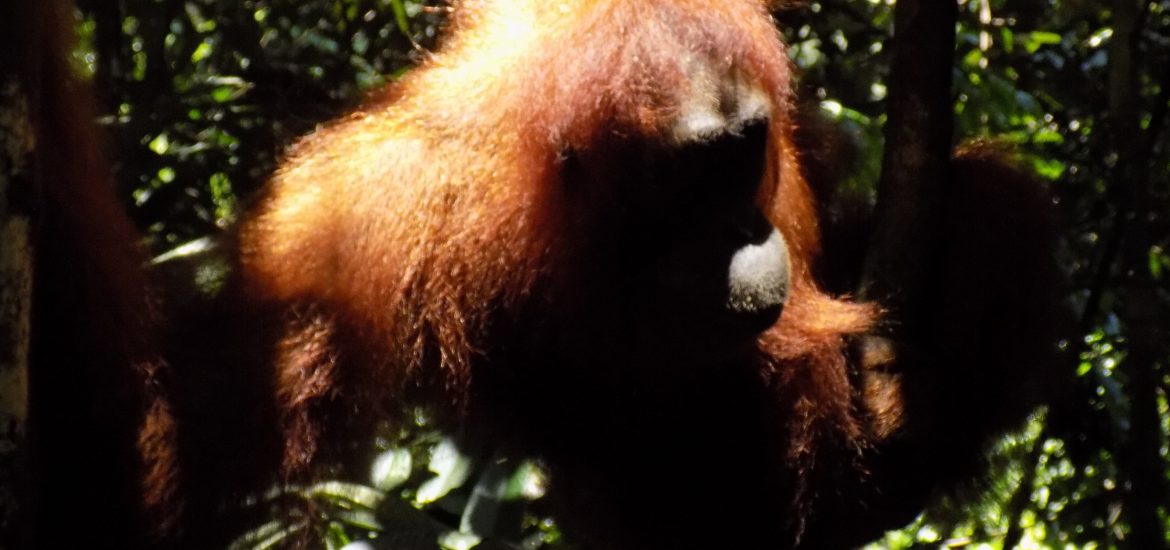One of my ultimate trip highlights was definitely seeing orangutans in Sumatra.
Like many tourists who arrive at Medan airport, we skipped the city and went straight to the jungle in Bukit Lawang. We had booked a two-day jungle trek through our hotel, Ecolodge Bukit Lawang. The hotel itself was amazing enough – nestled between the edge of the jungle and the river, we had to cross a rope bridge to get there, and the incredible bamboo building was a really inspiring space.

We began our trek the next morning. With backpacks on, we followed our guide Idris into the rubber plantation, and then into the jungle itself.

Followed by a swarm of mosquitos, it wasn’t long before we were sweating profusely, and the next few hours went by slowly as we trudged through the jungle. Eventually, and all of a sudden, we stumbled across some orangutans!
We were so overjoyed, as of course there is never any guarantee in the jungle that you will see these mysterious creatures. But here they were, and they were so close! We joined several other groups of tourists standing in hushed awe and taking pictures of these majestic tree-dwellers.


Eventually we trekked on for a few more hours, and we saw more orangutans!
Now before the trek started I didn’t realise that many of the orangutans on this jungle route are actually rehabilitated – rescued from the illegal exotic pet trade and reintroduced into the wild. In a way I was a little disappointed that they weren’t truly wild, as I’d read about rehabilitation efforts online before, so I was little skeptical. As we met more of these larger-than-life characters I realised that the issue, like many issues in conservation, is extremely complex. One the one hand, of course the fact that these animals are back in their natural habitat and protected from poachers is great – but on the other, they were pretty much tame, and extremely used to human interactions. (except for Mina – an aggressive orangutan who is famous for biting tourists – and who we luckily avoided on our trek!)
Of course if an orangutan is used to human contact – and relies on fruit offerings from guides and tourists to eat – then that is unlikely to change, and perhaps for some of the older generations, this is as ‘wild’ as they will ever really be. More troubling was the fact that many of these rehabilitated orangutans now have babies of their own, who are learning these behaviours.

We talked about these issues with our guide Idris, and he agreed that it is problematic, and not an easy question to answer. How can you continue to feed a mother and somehow not train her baby (who is literally attached to her most of the time) to do what she does?
After our night in the jungle we trekked back to the ecolodge, exhausted but happy we had seen these incredible animals, and so close too! (So close in fact that a couple got particularly ‘attached’ to Dave!)

Personally though I was much happier seeing the orangutans in the trees, doing what they do best. We were even fortunate enough to see this wild mama on our trek, which was extremely encouraging in terms of the nature reserve’s aims – to get the wild orangutan population back up to where it used to be.


As we left the ecolodge and began the long drive to Lake Toba we passed rows and rows of palm plantations. Reclaimed from the jungle, these trees are a big part of the reason that orangutans are endangered, as their territories are being eaten up by these eerily straight lines of trees, grown for their nuts to make palm oil.

As I reflected on this once-in-a-lifetime experience, I realised that we are all faced with choices everyday, and those choices have ripple effects throughout the world. I wanted to see orangutans and felt extremely lucky to do so, especially at such a close distance. However, there is definitely something undeniably special about seeing ‘wild’ animals. (I am using ‘quotation marks’ because the concept of wildness is contested anyway, and truly wild things are becoming fewer and farther between. But I digress…)
If these gentle, intelligent animals are to survive at all, then we have to fight to protect them. Sometimes that means not buying KitKats and other products containing palm oil – and sometimes that means contributing towards ecotourism, national parks and rehabilitation efforts.
Some other wildlife we saw in the jungle:






